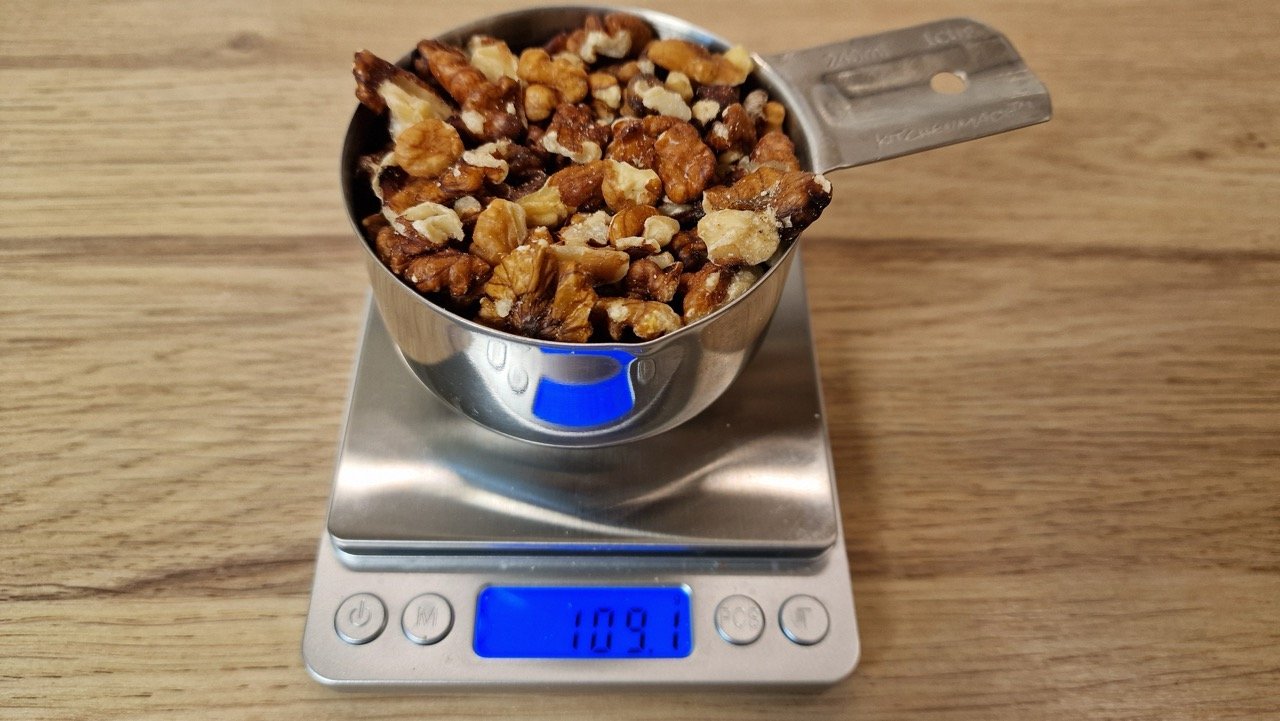Measuring ingredients accurately is essential in culinary arts, particularly when using ingredients like walnuts that significantly impact the texture and flavor of dishes. Walnuts are a popular choice in a variety of recipes, from baked goods like bread and cookies to savory dishes and salads. Their size, form (whole, chopped, or ground), and oil content make precise measurement crucial for ensuring consistent and tasty results.
This article will explore different methods to measure walnuts using various units such as cups, grams, ounces, and tablespoons, helping to maintain consistency and achieve perfection in your cooking and baking.
Understanding Walnut Measurements
Overview of Common Measurement Units
- Cups: Frequently used in recipes that call for large quantities of walnuts, particularly in baking.
- Grams: Provides precision, essential in recipes where the exact amount of walnuts can affect the balance of flavors and textures.
- Ounces: Useful for measuring walnuts when recipes specify weight for consistent results.
- Tablespoons: Ideal for when a smaller amount of walnuts is needed, such as in topping dishes or adding to salads.
Why Walnut Measurements Can Be Tricky
Walnuts can be challenging to measure accurately due to their irregular shapes and sizes, especially when they are whole. When chopped, walnuts can settle differently, leading to variability in volume measurements. The oil content in walnuts can also vary, affecting their weight and how they interact with other ingredients.
Practical Measurement Tips
How to Measure Walnuts Accurately
- Using Kitchen Scales: For the most precise results, especially when exact quantities are crucial, measuring walnuts by weight (grams or ounces) is advisable. This method avoids the pitfalls of volume measurement variability and is particularly important in precision baking.
- Proper Way to Fill a Measuring Cup: When using cups, gently spoon the walnuts into the measuring cup without packing them down.
Adjusting Recipes
The quantity of walnuts in a recipe can affect its texture and richness. If a dish is too dense or rich, slightly reducing the amount of walnuts may help balance it out. Conversely, if more texture or a richer nutty flavor is desired, increasing the walnuts can enhance these aspects. Mastery over adjusting walnut measurements can significantly improve the outcomes of specific recipes.
Nutritional Benefits of Walnuts
Walnuts are not only flavorful but also offer numerous health benefits, making them a valuable addition to any diet:
- Healthy Fats: Walnuts are high in omega-3 fatty acids, beneficial for heart health and reducing inflammation.
- Protein: They provide a good source of plant protein, essential for muscle repair and growth.
- Vitamins and Minerals: Rich in vitamins B6 and E, and minerals like magnesium and potassium, which are crucial for overall health and wellness.
- Antioxidants: Walnuts contain antioxidants that help reduce oxidative stress in the body, potentially lowering the risk of chronic diseases.
Walnut Conversion Tables And Formulas
Walnut is also called whole walnuts, English Walnut, Persian walnut, common walnut, Juglans regia. All names refer to the same ingredient, so conversion rates shown below are valid for each of these.
Most Common Conversions for Walnut
- 1 teaspoon of walnut: 2 grams.
- 1 tablespoon of walnut: 7 grams.
- 1 US cup of walnut: 109 grams.
- 1 UK cup of walnut: 114 grams.
Walnut US Cups to Grams and Ounces
| US Cups of walnut (whole walnuts, English Walnut, Persian walnut, common walnut, Juglans regia) | Amount in grams (g) | Amount in ounces (oz) |
|---|---|---|
| 1/8 cup | 14 g | 0.48 oz |
| 1/4 cup | 27 g | 0.96 oz |
| 1/3 cup | 36 g | 1.29 oz |
| 3/8 cup | 41 g | 1.45 oz |
| 1/2 cup | 55 g | 1.93 oz |
| 5/8 cup | 68 g | 2.41 oz |
| 2/3 cup | 73 g | 2.57 oz |
| 3/4 cup | 82 g | 2.89 oz |
| 7/8 cup | 96 g | 3.38 oz |
| 1 cup | 109 g | 3.86 oz |
| 2 cups | 219 g | 7.72 oz |
| 3 cups | 328 g | 11.57 oz |
| 4 cups | 437 g | 15.43 oz |
| 5 cups | 547 g | 19.29 oz |
| 6 cups | 656 g | 23.15 oz |
| 7 cups | 766 g | 27 oz |
| 8 cups | 875 g | 30.86 oz |
| 9 cups | 984 g | 34.72 oz |
| 10 cups | 1094 g | 38.58 oz |
Walnut UK Cups to Grams and Ounces
| UK Cups of walnut (whole walnuts, English Walnut, Persian walnut, common walnut, Juglans regia) | Amount in grams (g) | Amount in ounces (oz) |
|---|---|---|
| 1/8 cup | 14 g | 0.5 oz |
| 1/4 cup | 28 g | 1 oz |
| 1/3 cup | 38 g | 1.34 oz |
| 3/8 cup | 43 g | 1.51 oz |
| 1/2 cup | 57 g | 2.01 oz |
| 5/8 cup | 71 g | 2.51 oz |
| 2/3 cup | 76 g | 2.68 oz |
| 3/4 cup | 85 g | 3.01 oz |
| 7/8 cup | 100 g | 3.52 oz |
| 1 cup | 114 g | 4.02 oz |
| 2 cups | 228 g | 8.04 oz |
| 3 cups | 342 g | 12.05 oz |
| 4 cups | 456 g | 16.07 oz |
| 5 cups | 570 g | 20.09 oz |
| 6 cups | 684 g | 24.11 oz |
| 7 cups | 797 g | 28.13 oz |
| 8 cups | 911 g | 32.15 oz |
| 9 cups | 1025 g | 36.16 oz |
| 10 cups | 1139 g | 40.18 oz |
Walnut Tablespoons to Grams and Ounces
There is now real practical use in measuring walnut with a tablespoon. However, for complete conversion rates we give you the theoretical tablespoon measurements in grams.
| Tbsp of walnut (whole walnuts, English Walnut, Persian walnut, common walnut, Juglans regia) | Amount in grams (g) | Amount in ounces (oz) |
|---|---|---|
| 1/4 tbsp | 2 g | 0.06 oz |
| 1/3 tbsp | 2 g | 0.08 oz |
| 1/2 tbsp | 3 g | 0.12 oz |
| 1 tbsp | 7 g | 0.24 oz |
| 2 tbsp | 14 g | 0.48 oz |
| 3 tbsp | 21 g | 0.72 oz |
| 4 tbsp | 27 g | 0.96 oz |
| 5 tbsp | 34 g | 1.21 oz |
| 6 tbsp | 41 g | 1.45 oz |
| 7 tbsp | 48 g | 1.69 oz |
| 8 tbsp | 55 g | 1.93 oz |
| 9 tbsp | 62 g | 2.17 oz |
| 10 tbsp | 68 g | 2.41 oz |
Walnut Teaspoons to Grams and Ounces
There is now real practical use in measuring walnut with a teaspoon. However, for complete conversion rates we give you the theoretical teaspoon measurements in grams.
| Tsp of walnut (whole walnuts, English Walnut, Persian walnut, common walnut, Juglans regia) | Amount in grams (g) | Amount in ounces (oz) |
|---|---|---|
| 1 tsp | 2 g | 0.08 oz |
| 2 tsp | 5 g | 0.16 oz |
| 3 tsp | 7 g | 0.24 oz |
| 4 tsp | 9 g | 0.32 oz |
| 5 tsp | 11 g | 0.4 oz |
| 6 tsp | 14 g | 0.48 oz |
| 7 tsp | 16 g | 0.56 oz |
| 8 tsp | 18 g | 0.64 oz |
| 9 tsp | 21 g | 0.72 oz |
| 10 tsp | 23 g | 0.8 oz |
Metric vs. Imperial Conversions
When working with walnut in the kitchen, it's essential to be adept at converting between the metric and imperial systems of measurement. This skill ensures accuracy in following recipes from different culinary traditions around the world.
The metric system, commonly used around the world, measures walnut primarily in grams and kilograms. This system is favored for its simplicity and ease of scaling.
Predominantly used in the United States, the imperial system measures walnut in tablespoons and teaspoons. While not as straightforward as scaling, it is deeply integrated into many traditional American recipes.
Common Measurement Units for Walnut
Walnut can be measured by either volume or weight. Ingredients that come in large pieces, such as walnut, are the worst to be measured by volume (e.g. cups). Cups measurement for walnut are very unreliable, different measurements can differ by even more than 20%. Use a kitchen scale instead for precise measurement.
Most typical volume measurements for walnut are:
- Teaspoons (tsp)
- Tablespoons (tbsp)
- Cups
Most typical weight measurements for walnut are:
- Ounces (oz)
- Grams (g)
- Kilograms (kg)
- Pounds (lbs)
How We Measure Walnut?
To make sure that our conversion rates are correct, we don't just copy data from other websites. We actually take at least 5 different measurements of 1 cup of walnut and use the average for calculations and conversion tables. Read more on our measurement methodology by clicking on this link.

